Contact us
Grinding
Grinding constitutes the second stage of fragmentation. It handles already reduced materials (< 10 mm) and brings the particle sizes to micrometric dimensions. It operates through dry or wet (pulp) sorting.
Different techniques to various degrees implement principles such as crushing, impact, attrition and abrasion. This operation, taken as far as the levels of micronisation, can at the extreme lead to the amorphisation of crystalline structures made use of in mechano-chemistry to functionalise the materials (manufacturing of new binders, activation, etc.).
| Type | Type | Materials | Particle size In (d100) | Particle size Out (d50) | Capacity max |
|---|---|---|---|---|---|
| Vertical axis mill |
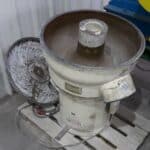
|
Half-hard, soft and brittle | 0 - 2 mm | 0 - 30 µm | Batch 2 kg |
| Vibrating ball mill |

|
Hard, abrasive and brittle materials | 0 - 200 mm | 0 - 30 mm | 1 t/h |
| 0 - 80 mm | 0 - 10 mm | 100-200 kh/h | |||
| 0 - 50 mm | 0 - 2 mm | 100 kg/h | |||
| Vibrating rod mill | Hard, abrasive and brittle materials | 0 - 20 mm | 0 - 1 mm | Batch 2 kg | |
| 0 - 30 mm | 0 - 2 mm | 200 kg/h | |||
| Disc mill |
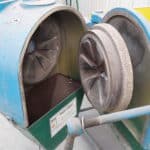
|
Hard and abrasive materials | 0 - 25 mm | 0 - 5 mm | 30 à 500 kg/h |
| Percussion mill |
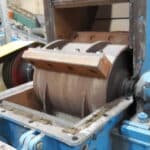
|
Half-hard to soft materials | 0 - 20 mm | Grille de 8 mm à 80 µm | 0 - 100 kg/h |
| Hammer mill |
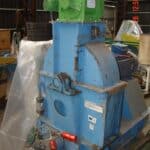
|
Soft, brittle and fibrous materials | 0 - 30 mm | 0 - 100 µm | 1 t/h |
| Semi-autogenous |
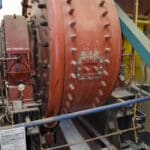
|
Hard, abrasive and brittle materials | 0 - 10 mm | 0 - 0,5 mm | 200 kg/h |
| Spindle disintegrator | Soft and dry materials | 0 - 2 mm | 0 - 100 µm | 50 à 100 kg/h | |
| 0 - 10 mm | 0 - 100 µm | 500 kg/h |
Micronisation
| Type | Type | Materials | Particle size In (d100) | Particle size Out (d50) | Capacity max |
|---|---|---|---|---|---|
| Air-jet mill | Half-hard to soft | 0 - 1 mm | 0 - 5 mm | 1 - 2 kg/h | |
| Vibro-grinder | Hard to soft | < 10 mm | 0 - 50 µm | 50 à 100 cm³ | |
| Planetary | Hard to soft | 0 - 3 mm | < 30 µm | 50 cm ³ |
Work Bond Index (WIB)
The Work Bond Index is an index which enables, in accordance with a standardised procedure, the establishing of the energy consumption for the milling of a given material and the dimensioning of the mill. The CTP is equipped with a standard ball mill allowing the establishment of this index. The value obtained corresponds to the theoretical power needed for the milling of a short ton (sh.t, or 907.18 kg) in a ball mill of eight feet in internal diameter, with discharge by overflow, operating through wet sorting in a closed circuit. In Bond’s theory, correction factors are then applied to take into account the standard conditions of the procedure, in particular for the milling conditions or the diameter of the mill.
All
Our expertises